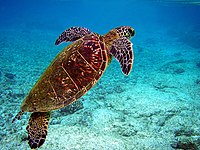
Photo from wikipedia
Loggerhead turtles (Caretta caretta) voluntarily ingest floating plastic debris and hence are chronically exposed to plastic additives, but very little is known about the levels of these compounds in their… Click to show full abstract
Loggerhead turtles (Caretta caretta) voluntarily ingest floating plastic debris and hence are chronically exposed to plastic additives, but very little is known about the levels of these compounds in their tissues. This work studied the presence of organophosphate esters (OPEs) on sea turtles collected from two different areas in the western Mediterranean, some of their prey and some floating plastic debris. OPEs were detected in all the samples analysed and ∑OPEs ranged from 12.5 to 384 ng/g wet weight (ww) in the turtles from the Catalan coasts, with a mean value of 21.6 ng/g ww, and from 6.08 to 100 ng/g ww in the turtles the Balearic Islands, with a mean value of 37.9 ng/g ww. Differences in ∑OPEs were statistically significant, but turtles from the two regions did not differ in their OPE profiles. As per turtle's prey, ∑OPEs ranged from 4.55 to 90.5 ng/g ww. Finally, marine plastic litter showed ∑OPEs concentrations between 10.9 and 868 ng/g. Although most compounds were present in both potential sources of contamination, prey and plastic debris, the OPE profiles in loggerhead turtles and these sources were different. Some OPEs, such as tris(2-isopropylphenyl) phosphate (T2IPPP), tripropyl phosphate (TPP) and tris(2-butoxyethyl) phosphate (TBOEP), were detected in plastic debris and turtle muscle but not in their prey, thus suggesting that ingestion of plastic debris was their main source. Contrarily, the levels of triethyl phosphate (TEP), diphenyl cresyl phosphate (DCP), 2-isopropylphenyl diphenyl phosphate (2IPPDPP) and 4-isopropylphenyl diphenyl phosphate (4IPPDPP) in turtle muscle were much higher than in jellyfish, their main prey, thus indicating a biomagnification potential. Regular ingestion of plastic debris and contamination from their prey may explain why ∑OPEs in loggerhead turtles is much higher than the values reported previously for teleost fishes and marine mammals from the western Mediterranean.
Journal Title: Environmental pollution
Year Published: 2021
Link to full text (if available)
Share on Social Media: Sign Up to like & get
recommendations!